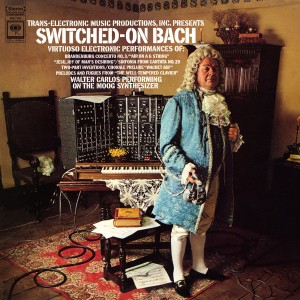 It was 50 years ago today (well almost) Wendy Carlos released what was to be for ages the best selling Classical record of all time called “Switched-On Bach”. For a while, it was even outselling The Beatles!
It was 50 years ago today (well almost) Wendy Carlos released what was to be for ages the best selling Classical record of all time called “Switched-On Bach”. For a while, it was even outselling The Beatles!
The Moog Modular was in its infancy. Wendy was pals with Bob Moog and they traded ideas to help develop the fledgling synthesizer from a lab device into a performance instrument. Some things we take for granted now in our synths, we owe to Wendy.
“Switched-On Bach” managed to launch wave after wave of electronic musicians of varying success; from Mort Garson & Larry Fast to Keith Emerson & Jarre.
When I decided to tribute Wendy and “Switched-On Bach”, “Toccata & Fugue in D Min” was the obvious choice as it was the record I used to sneak out and play alongside Deep Purple and Duran Duran.
I wasn’t sure where to start so I downloaded a MIDI File from the internet, assuming the notes are correct and set about assigning sounds. At first, it seemed very random as while I know the intro, I couldn’t say I understood the rest of the piece.
It worried me that my sounds were seeming to echo very closely those chosen by Wendy (and Sky from their 1980 “Toccata” track). Yes, they probably are but at the same time, they are the sounds that came out and suit the notes. I was deliberately not trying to break any new ground here but to reflect on the music and the way Wendy Carlos re-imaged it for us.
What I learned from being in-the-notes was that, as the title suggests, Bach’s “Toccata & Fugue in D Min” is in effect in two parts. There is that dramatic intro which gives way to a floating & almost ambient section, tied up with a return of some of the elements from the intro. This is a very visual piece. Would perhaps be interesting to know what Bach was thinking – but then again maybe it wouldn’t as he may only have been thinking about his tea.
Wendy Re-Imaged
If you look at the album cover you will see the album is credited to Walter Carlos, not Wendy. This is because at the time Wendy was still Walter. Later pressings, this was changed.
Wendy lived with what we now call gender dysphoria which is where the brain’s view-of-self doesn’t match the physical body. That is, in this case, Walter could see boy parts on the outside but felt like a girl on the inside. Gotta be a hard road.
Back in the 60’s, this was still a relatively new official medical situation even though nature has no doubt created these cases since at least caveman days. Four years after the release of the record, and as a result of the money earned, Wendy was able to make her body & brain match with surgery.
Sadly it took another 7 years for Wendy to “out” herself in what at the time was a bold move. I think it great that she chose Playboy for this as it really felt to her the best publication (at that time Playboy was known for stellar journalism as well as a sense of personal freedom). Wendy sees those years of hiding her (now realized) self from the world as being a waste.
While this tribute is mostly about Wendy’s musical work (and Bach) it frustrates me that I have encountered several people active in “trans” issues who have no idea who Wendy Carlos is. This seems sad as Wendy was one of the first famous people to transition publicly. Wendy was ‘successful’ in this and should be held up as proof that gender and transition are not the sticking points some people want to make them.
In reality, Walter becoming Wendy was a bit of a non-event in the real world. Wendy acknowledges herself that it really made no difference. People barely cared. She was seen as a musician and stayed that way.
The release of “Switched-On Bach” set all those events in motion. This is not a thing that should be easily forgotten by anyone.
 Over the next four weeks, I will be releasing a re-imaged Bach piece every week. This will culminate with the album itself on 1st October to make it exactly 50 years since Wendy’s record came out and changed our world.
Over the next four weeks, I will be releasing a re-imaged Bach piece every week. This will culminate with the album itself on 1st October to make it exactly 50 years since Wendy’s record came out and changed our world.
I haven’t included photos of Wendy. Not because I don’t want to but because I know she is rather private and also very territorial. There are a lot of photos of Wendy on her site at www.wendycarlos.com.





Amazing to think that is 50 years old. I would be curious to know if you have anything up your sleeve as to a modern day example of something that pushes the boundaries as much as that. It doesn’t seem like a whole lot has been achieved since then except possibly accessibility to digital recording. Maybe there is a secret society doing freakish sound experiments somewhere like these people.
Thanks, Ian. Sadly no I don’t know of anything that I think is doing anything interesting that particularly opens new vistas. Yes the DAW opens a lot of space for people to make but I must say mostly I only see “me too” material instead of finding new ways to express the human spirit. To me right now that is the thing as Art is currently so much about people making “ego noise” and that 5yo ego thing is the challenge for the whole human race to overcome. Until we do that new technologies etc are moot. Nothing is anything until people are again interested in listening and talking instead of simply posting and engaging in what terrible thing Trump or the Kardashians are doing.
I enjoyed both the recordings so far. I bought the record when I was in college not too long after it came out. It was one of those “must have” records that just about every who could afford it bought, like the 2001 and Woodstock soundtracks.
I had also purchased a couple recordings of electronic music shortly before that. They were more interesting than enjoyable, and I didn’t listen to them a lot. I think being able to add the new sound of the Moog to the familiar structure of Bach helped Wendy break through the pop music wall and gain awareness from a wide audience.
I don’t remember reading a lot about Wendy for a while as she was transitioning. And my listening habits drifted to a mixture of classical music and jazz, especially Miles Davis. So I was glad to learn she had built a new career in movie composing.
A lot of rock bands went on to use synthesizers as part of their sound, but most of what is being done now is just background noise without creativity or artistry.
Hi Joni, Thanks for commenting. I’m glad you liked the re-voicings.
Yes, timing was very much on Wendy’s side here. Her success really elevated the synthesizer from a pure novelty to a valid instrument.
And yes sadly today, much of what synths are used for is really somewhat demeaning to the instrument and the idea of music in general. The software studio opened a lot of doors but also opened the door for a lot of ego-noise.
🙂